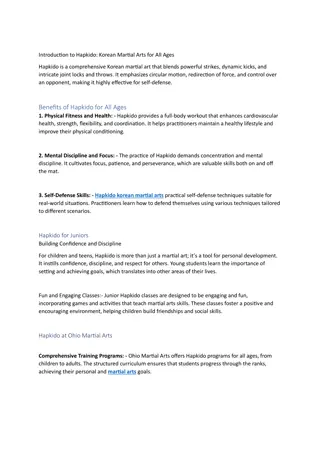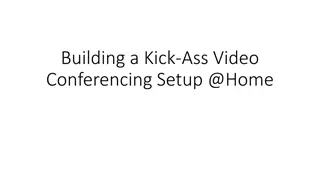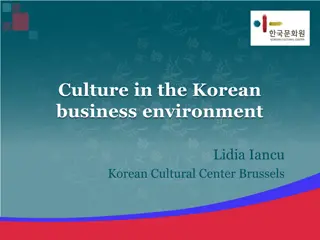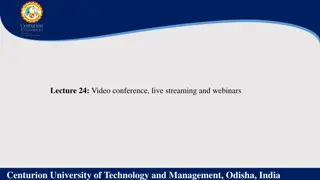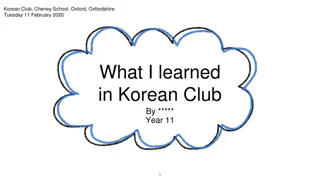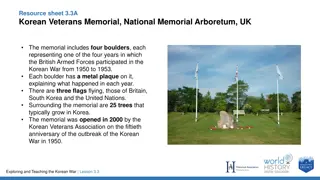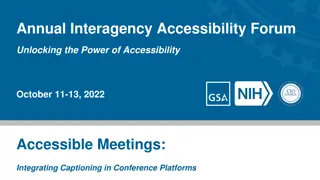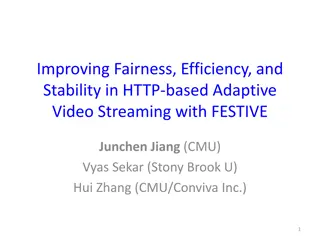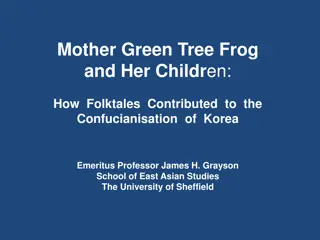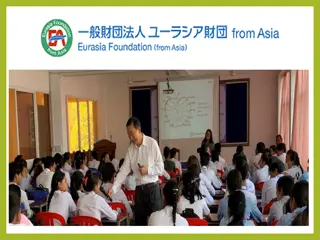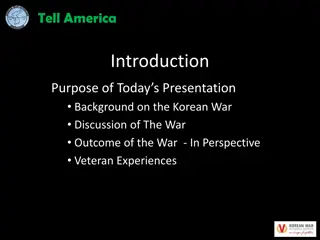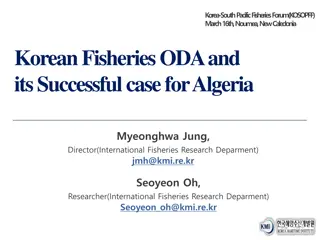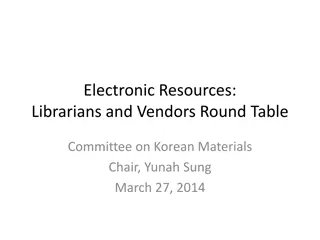Enhancing Korean Language Instruction through Video-Conferencing
Exploring ways to advance Korean language learning beyond traditional classroom settings, this study by Dr. Byung-jin Lim focuses on the use of video-conferencing for intercultural and linguistic exchange. The aim is to provide a platform for interactive communication and learning opportunities, expanding horizons for learners of Korean.
Download Presentation

Please find below an Image/Link to download the presentation.
The content on the website is provided AS IS for your information and personal use only. It may not be sold, licensed, or shared on other websites without obtaining consent from the author. Download presentation by click this link. If you encounter any issues during the download, it is possible that the publisher has removed the file from their server.
E N D
Presentation Transcript
1 Intercultural and Linguistic Exchange in a Video-Conferencing Study Byung-jin Lim, Ph. D. (University of Wisconsin) blim3@wisc.edu AATK: June 26th, 2010
Rationale How to move Korean language instruction beyond classroom activities How to motivate Korean language learners to get involved in activities based on what they have learned in class How to provide authentic materials to Korean language learners by using current technology 2
Outline of the Talk Background The Current Study Findings Challenges Discussions 3
KLP at UW-Madison 5 Years of Korean language Instruction a) 1st Year Korean b) 2ndYear Korean ( ) c) 3rd Year Korean d) 4th Year Korean e) 5th Year Korean (i.e., Advanced Writing for Business and Research) 4
East Asian Languages (CJK) at UW-Madison Level Chinese Japanese Korean 1st Year 8 hours 8 hours 5 hours 2nd Year 8 hours 8 hours 5 hours 3rd Year 5 hours 5 hours 3 hours 4th Year 4 hours 3 hours 3 hours 15 wks*2 sems Chinese Japanese Korean 1st Year 240 hours 240 hours 150 hours 2nd Year 240 hours 240 hours 150 hours 3rd Year 150 hours 150 hours 90 hours 4th Year 120 hours 90 hours 90 hours Total 750 hours 720 hours 480 hours 5
Video-Conferencing in the Korean Language Program (KLP) at UW-Madison 6
Questions Why video-conferencing in the KLP? How does the video-conferencing in the KLP contribute to students proficiency in Korean? If so, how do we know that? Given the current circumstances of Korean language education in the U.S., how realistic is it to do video- conferencing in the KLP? 7
Computer-Mediated Communication (CMC) Computer-Mediated Communication (Herrings 1996: p. 13): Communication that takes place between human beings via the instrumentality of computers The pedagogy of using CMC helps the development of second/foreign language linguistic competence (Abrams 2003, Belz 2003, Warschauer 1997, Warschauer & Kern 200). CMC tools facilitate the process of communication, social interaction, language development, and cultural understanding (Sociocultural Theory: Vygotsky 1978, 1986) 8
CMC in Foreign/Second Language Learning CMC Mode a) Synchronous: Real-time interaction b) Asynchronous: Delayed interaction CMC Tools a) Text-based: e.g., Instant text message, Message board b) Audio-based: e.g., Phone chat c) Video-based: e.g., Video-chat/conferencing 9
Previous CMC Studies in Language Education Studies Language CMC Tool Chun (1994) German Text-based Kern (1995) French Text-based Warschauer (1996) ESL Text-based Pellettieri (2000) Spanish Text-based Toyada & Harrison (2002) Japanese Text-based Pyun (2003) EFL Text-based Tudini (2003) Italian Text-based Thorne (2003) French Text-based Spanish Videoconference O Dowd (2000) Wang (2004a, b, 2006) Chinese Videoconference Xiao (2007) EFL Videoconference EFL Text-based & Videoconference O Dowd (2007) 10 H.J. Lee (2009) EFL Videoconference
Text-Based CMC L2 learners often do not have sufficient opportunities to use the target language outside the classroom, and text- based CMC offers learners more opportunities to use the target language to interact with native speakers. It offers a learning environment where participants have less anxiety, enjoy equal participation, and are more motivated to communicate with others using the target language. 11
Why Video-Conferencing? Text-based CMC requires writing appreciation and typing skills. Text-based CMC lacks certain features such as voice, intonation, gesture, and body language which is significant factors for successful communication. Video-Conferencing provides an environment which is similar to face-to-face discussion and yet, it offers learners less anxiety and more control. It invites more participation. Therefore, the learners can be more comfortable, confident and creative. 12
The Current Study Is designed for non-native language learners of Korean & English to aim at developing intercultural communicative competence (ICC) as well as linguistic competence by providing the learners with the target language and culture through Internet-based video-conferencing. ICC: The capacity to mediate multiple cultural identities and situations (Byram 1997) 13
Participants KOREAN: 19 students of 2nd Year Korean at UW-Madison (or Intermediate Korean-level with more than 160 hours of classroom instruction) ENGLISH: 31 students of English Conversation & Grammar at Handong Global University (or Intermediate English-level) UW-Madison 1) Located in Madison, WI 2) 4-year State University 3) 40,500 students 4) UW-Madison is the flagship campus of the University of Wisconsin System categorized as a very high research activity university Handong Global University 1) Located in Pohang, Korea 2) 4-year private college 3) 3,500 students 4) Emphasizes academic excellence, language skills, computer proficiency, and Christian commitment 14
Diverse Student Make-Up 2nd Year Korean at UW-Madison (19 students): 1) Caucasian: 21% 2) African-American: 5% 3) Hmong-American (cf. Wisconsin & Minnesota): 26% 4) Chinese/Taiwanese/Japanese: 32% 5) Korean-American (cf. half-Korean): 11% 6) Korean-heritage Adoptee (cf. Wisconsin & Minnesota): 5% 15
Procedures All the participants discuss a topic in English one week, and then switch to Korean the following week. Discussion topics were given by the instructors of both schools prior to students video-conferencing. The video-conferencing was held every week for 6 weeks for 50 minutes. At the end of each video-conferencing session, all participants wrote a short journal entry in the language designated that week for video-conferencing. 16
Topics with three tasks Information exchange tasks: personal biographies, local schools or town or aspects of their home cultures Comparison and analysis tasks: Carrying out comparisons or critical analyses of cultural products from both cultures Collaborative tasks: Working together to produce a joint product or conclusion 17
Sample Discussion Topics Week # Topic Language 1 Introducing yourself, school, town, country : , , , English 2 Korean 3 Manners and etiquettes English 4 Korean 5 Korean Pop Culture English 6 Korean 6 Collaborative Write-up Korean 18
A sample of weekly preparation for video-conferencing Topic 1 Language Date Task Introduce Topic 1 and do two free-writing activities: 1) Have students write a short journal about themselves in 5 minutes (e.g., family, hobbies, favorite books ) 2) Have students write a short journal about UW- Madison, Madison, Wisconsin, and U.S.A. in 5-7 minutes Review the free-writing activities Make groups of three students and then let them discuss & develop a questionnaire (with at least 7 questions) Write the questionnaire on an index card for video-conferencing Introduction English 9/21 (M) 9/23 (W) 9/25 (F) Video-conferencing using Skype 19
Multi-Modal Skype: audio, video and text 21
Video-Conferencing between UW (19) and Handong (31) 22
Findings Based on: 1) Interviews 2) Participant Observations 3) Evaluation of Student Journal Entries 4) Post-videoconferencing Questionnaire 23
Information Exchange and Comparison & Analysis My partners were S and H. Both are fourth year students as well as double majors, one in English and Accounting and the other English and Sociology. H has been to the majority of Europe as well as Mongolia as part of a trip .I haven t traveled as much in America but I was able to share experiences from when I went to Washington D.C. and Atlanta (Student V.L.Y.) During the conversation, we also shared some experience of studying abroad, because she was an exchange student in UK for a year. when I was talking about Chicago and Madison, she seems to have a clear image of what I was describing. (Student Y. Y.) I really enjoyed hearing about the differences between traditional and modern weddings. They (my partners) were very much interested in the ceremonies and banquets of U.S. weddings and asked many questions about them. We all enjoyed talking about this subject very much (Student A.Z.) 24
Developmental Steps of ICC (ICC: Intercultural Communicative Competence) Observe the new activities (language and culture) 1) Accept the difference of the new activities 2) Learn about the new activities knowledge 3) Reflect their own activities (language and culture) and re-interpret them 4) Become self-aware of the differences and similarities between the two (your language and cultures and their language and cultures) 5) Internalize this awareness acquire 6) 25
Developing ICC: Honorifics Elders are highly respected in Korea so you must always show respect to them not only with your physical actions but also with the language you use toward them . (Student J.K.) At first, I just asked if an older person would get offended or angry if I accidently used inappropriate speech styles to talked with them. Both of them agreed that it would probably happen .they, then, asked if it would be similar in America. I tried to explain that although there isn t a specific speech style in English, adults can get very offended when certain slang or tones of voice are used with them from younger people (Student A. B.) My partner asked how we change speech styles in English. While it was a bit difficult to answer, I explained about the conditional, vocabulary differences, and some titles that we use (Student M.S.) 26
Technical difficulty Skype kept dropping our video call and froze many times. My status and their status were offline the whole time (Student J.Y.) I could hear him perfectly well and see him clearly but he couldn t hear me well and couldn t see me clearly either. (Student P.S.V.) There were only little technical difficulties. My laptop froze a little and I think the Internet connection wasn t strong. Other than that, it was fine. (Student V.L.) 27
Problem Solving Strategy We had to restart a few times, but after a while, it worked. (Student J.J.W.) Audio was good and we both could hear each other clearly (Student J. Y.) Each time we tried to video-chat, the video wouldn t work or he couldn t hear me. Thus, we ended up just IM- ing to each other. (Student M.B.) 28
Post-Video-conferencing Questionnaires Categories: 1) Topics/Preparation 2) Video-conferencing 3) Language Use ( ) 4) Follow-Up 29
1) Do you think your current Korean proficiency was at an acceptable level for you to carry on conversations with your partners during the conferencing? Q1 Your Current Korean Proficiency Acceptable? 10 9 8 7 6 5 4 3 2 1 0 Yes Somewhat Yes Not Sure Somewhat No No 30
2) Do you think your partners English proficiency was at an acceptable level for you to carry on conversations with him/her during the conferencing? Q2 Your Partner's English Proficiency Acceptable? 10 9 8 7 6 5 4 3 2 1 0 Yes Somewhat Yes Not Sure Somewhat No No 31
3) Do you think this video-conferencing project improved your Korean proficiency? Q3 Videoconference improved your Korean? 10 9 8 7 6 5 4 3 2 1 0 Yes Somewhat Yes Not Sure Somewhat No No 32
How do we know that video-conferencing really contributed to the students Korean Proficiency? TOPIK (Test of Proficiency in Korean) UW-Madison as TOPIK test cite since 2007 All the KLP students at UW-Madison take TOPIK as a way of evaluating their Korean Proficiency TOPIK Certification: 50% - cutoff for passing in four areas: 1) Grammar/Vocabulary, 2) Listening, 3) Reading and 4) Writing a) 50~70% - Level 1 certified b) 71% or higher Level 2 certified c) 33
Status of TOPIK at UW-Madison (2007-2010) Year # of Participant s (2nd Year Korean) Fail* Level 1 Level 2 2007 8 2 2 4 2008 2009 11 11 1 1 4 5 6 5 2010 18 1 7 10 34
Detailed Look at TOPIK Scores (2008-2010) Average 80 70 60 50 40 30 Reading Gmr/voca 20 10 2008 2009 0 2010 Listening Writing 35
Challenges Time difference between UW and Handong a) 10:00am (UW) Midnight (Handong) b) 7:00pm (UW) 9:00am (Handong) Collaborations between the two (e.g., Academic calendars, instructors, students and more) Institutionalized support (e.g., Computer-lab, head-sets with microphones, video-cam ) 36
Discussions The study is a work in progress (2009-2011) Students (L2 language learners) as active explorer in inter- and intra-cultures Teachers not only as facilitators, lesson planners, and tech consultants, but also as intercultural partners (O Dowd, 2007) 37
Unanswered Questions Given the current circumstances of Korean language education in the U.S., how realistic it is to do video- conferencing in the KLP? Whether and how can we incorporate video-conferencing into our language education curriculum? 38
References Toyoda, E., & Harrison, R. (2002). Categorization of text chat communication between learners and native speakers of Japanese. Language Learning & Technology, 6 (I), 82-99. Tudini, V. (2003). Using native speakers in chat. Language Learning & Technology, 7 (3), 141-159. Thorne, S. L. (2003). Artifacts and culture-of-use in intercultural communication. Language Learning & Technology 7 (2). 38-67. Vygotsky, L.S. (1978). Mind in society. Cambridge, MA: Harvard University Press. Vygotsky, L. S. (1986). Thoughts and language. Cambridge, MA: MIT Press (Original was published in 1934) Vygotsky, L. S. (1997). The collected works of L. S. Vygotsky, Volume 4: The history of the development of higher mental functions. New York: Plenum. Wang, Y. (2004a). Distance language learning: Interactivity and fourth generation Internet-based videoconferencing. CALICO Journal, 21 (2), 373-395. Wang, Y. (2004b). Supporting synchronous distance language learning with desktop videoconferencing. Language Learning & Technology, 8 (3), 90-121. Warschauer, M. (1997). Computer-mediated collaborative learning: Theory and practice. Modern Language Journal, 81: 470-481. Warschauer, M., & Kern, R. (2000). Network-based language teaching: Concepts and practice. Cambridge: Cambridge University Press. Xiao, M. (2007). An empirical study of using internet-based desktop videoconferencing in an EFL setting. Doctoral dissertation, Ohio University. 39
References continued Abrams, Z. I. (2003). The effects of synchronous and asynchronous CMC on oral performance. Modern Language Journal, 87 (2): 157-167. Agar, M. (1994). Language shock: Understanding the culture of conversation. New York: William Morrow. Belz, J. A. (2003). Linguistic perspectives on the development of intercultural competence in telecollaboration. Language Learning & Technology, 7 (2): 68-117. Byram, M. (1997). Teaching and Assessing Intercultural Communicative Competence. Clevedon, UK: Multilingual Matters. Chun, D. M. (1994). Using computer networking to facilitate the acquisition of interactive competence. System, 22 (1), 17-31. Herrings, S. (1996). Computer-mediated communication: Linguistic, social, and cross-cultural perspectives. Amsterdam: John Benjamins. Kern, R. (1995). Restructuring classroom interaction with networked computers: Effects on equality and characteristics of language production. The Modern Language Journal, 79, 457-476. Kramsch, C. (1998). Language and culture. Oxford: Oxford University Press. Lee, H. J. (2009). Internet-mediated videoconferencing for the development of intercultural communication in second language (L2) Education. Doctoral dissertation, the University of Wisconsin-Madison. O Dowd, R. (2007). Evaluating the outcomes of online intercultural exchange. ELT Journal, Volume 61: 144-152. Pyun, O.C. (2003). Effects of networked language learning: A comparison between synchronous online discussions and face-to-face discussions. Doctoral Dissertation, The Ohio State University. Scollon, R., & Scollon, S. (2001). Intercultural communication (2nd edition). Cambridge: Blackwell. 40
Acknowledgment This research was supported by the Academy of Korean Studies Grant (AKS-2009-R-84) 41












